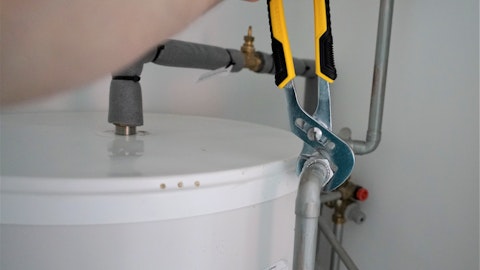But when those opportunities present themselves, we’re ready to execute on that again. So again, like we said, in remaining balance with share repurchase going forward. So, I think you’ll see next year and beyond utilizing that full balance sheet capacity and our ability to allocate that where we see fit from an allocation standpoint.
Todd Adams: Yes, Bryan, maybe one thing to add was Mark mentioned that – we’d be back, but we never left. I mean, we continue to cultivate things that are important to us. Obviously, if something of high strategic value would have decided, or wanted to do a transaction over the course of last year, we would have done it. We’ve got the capability, the resources to do that and integrate it extraordinarily well. I think, as we’re proving with the Elkay transaction. So everything else he said is clear. I just want to make sure that the distinction is we never left.
Mark Peterson: And we didn’t miss anything.
Bryan Blair: Definitely understood. Thanks again, guys.
Operator: Our next question comes from Mike Halloran from Baird. Please go ahead. Your line is open.
Unidentified Analyst: Hi. Good morning, everyone. [Here Pez] on for Mike. If we could maybe revisit the new filter that got released that we talked about a little bit last quarter, can you maybe talk about some of the adoption and the reception? Then I want to go back to a comment I believe Mark made, filtration being a bit of a smaller base. When you speak to the filtration piece, is that specifically the aftermarket filter replacement piece? Or is there also a little bit of an element of attachment to the OE bottle filler as well?
Todd Adams: Yes. I mean, I guess in terms of the PFOA, PFAS filter it’s brand new. I think we’re selling thousands of them to-date. But I don’t think that’s something that we’re counting on as being a massive catalyst immediately. But I think the slow, steady build of that amidst a large and growing installed base of units, is sort of the way to think about it. And in terms of the size or the scale of it, obviously the way to think about it is there are units installed in the field. And then there is a normal sort of replacement pattern. And so the mix of filtered versus non-filtered units and then the rate of attachment, or replacement value against those installed bases is sort of the algorithm. And so, if you think about more units going into the field, more of those units being filtered, and then the attachment rate moving from less than one-time a year to maybe just a little bit above that, the compounding benefit of that is huge.
So I think the way to think about it is, if the installed base grows at 10% a year, the attach rate can grow materially higher than that. And as Mark talked about, the profitability for drinking water and filtration are each very attractive.
Unidentified Analyst: Great. That’s super helpful color. And then just one clarification. We’ve gotten a couple questions on it this morning. On the 2024 assumptions on the slide here, drinking water is separate from institutional, correct? We are thinking about institutional completely separate from drinking water. We’re not saying that institutional with drinking water is up low single-digits, correct?
Mark Peterson: What we were highlighting on the institutional market, is going to grow low single-digits. But we think if you look at our drinking water franchise in the context of all of our end markets, it grows at a double-digit pace. A lot of that, obviously, coming from our actions, our initiatives versus what the market may do next year.
Todd Adams: Yes, I mean, maybe just to touch differently, I believe that we’re highlighting that inside of institutional, the drinking water business for us, will grow at a double-digit rate. So it’s inclusive of the low single-digit. Institutional is inclusive of double-digit drinking water.
Unidentified Analyst: Understood. Thank you. I’ll pass it on.
Operator: Our next question comes from Jeff Hammond from KeyBanc Capital Markets. Please go ahead. Your line is open.
Jeff Hammond: Yes. Good morning, guys.
Todd Adams: Good morning, Jeff.
Jeff Hammond: Hi, just – so just following up on that, because a little confusion on the kind of the end market assumptions. I think you said, Mark, all-in, you think your end markets are kind of flat to slightly down. Is that correct? And then institutional ex drinking water, you think is, maybe if you pull out that drinking water, it’s more like slightly down versus up low single-digits?
Mark Peterson: No, I don’t think we said that. I think – I don’t think there’s a lot of confusion. I think we’re trying to highlight the fact that agnostic from maybe how we would call the end markets. Drinking water is growing at that double-digit rate. I think in aggregate, we still believe institutional is up – as an end market, commercial is down as we highlighted. I think that’s the way to think about it, Jeff.
Jeff Hammond: Okay. So, if I did the math on kind of the growth, it seems like your end markets are maybe growing to 2, 2.5 and then you get maybe a point of price and a point outgrowth. Is that the way to think about the growth algorithm in ’24?




